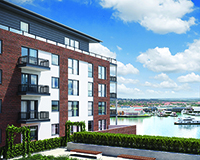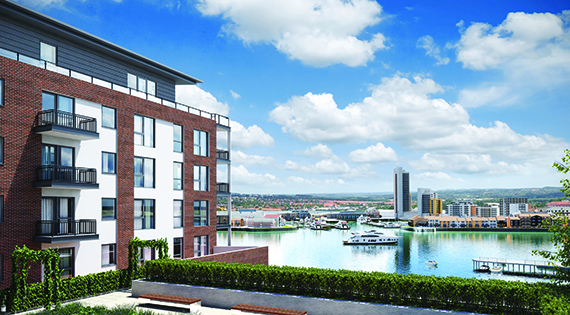London, Manchester and Edinburgh may be stealing a march when it comes to PRS headlines but it is unassuming Southampton that is an unsung hero of the sector.
Two years ago it was the UK’s first city to benefit from the then-coalition government’s Build To Rent programme, when it was announced that 102 of 1,600 homes to be built by Crest Nicholson on the Centenary Quay site – the old Vosper Thornycroft shipyard at Woolston – were to be designated for PRS. The project received a helping hand of £7.5m from the government.
Those units are due for completion in January 2016 and Crest has now sold them to shared ownership and affordable home specialist A2 Dominion Group, which says it will manage them as PRS units.
But that is not Southampton’s only first in this sector. Early this summer giant US housing specialist Atlas Residential – which operates 75,000 units across 13 states and is valued at close to £7bn – chose Southampton for its debut into the emerging UK market. Working alongside Rockspring Property Investment Managers it has purchased a 145,500 sq ft site from Southampton council within walking distance of the city centre’s main retail and marina areas. It is to host 211 PRS units, which Atlas will design, build and manage.
Atlas UK managing director Jonathon Ivory says this scheme will be a test bed for how the firm’s US-style “amenity and customer service-centric” philosophy will play in the UK, while Rockspring’s European director, Eric Linden, believes what he calls Southampton’s “macro and micro market fundamentals” make it a compelling choice.
“As the Solent continues to gain traction as one of the leading investment destinations within the UK, with a 43% increase in residential property values predicted by 2019, we believe we’re well positioned to capitalise on the growing population and subsequent economic growth,” he says.
The contracted developer, Hampshire & Regional, started on site this autumn and the £36m scheme will be delivered in phases, completing in late 2017.
On a smaller scale – but another first, at least of a sort – is the 30-home scheme at Oak Tree Place, which is under construction. This is the debut PRS offering from mainstream housebuilder Bovis Homes, and is part of its 190-home PRS joint venture with Mill Group across a range of sites in the south of England.
So for a city of 260,000 residents, Southampton’s PRS scene is already busy: study the statistics and you can understand why.
Hometrack data consultancy says the average gross residential rental yield in the city is 5.9%, while HSBC lists Southampton as Britain’s single best location for individual buy-to-let investors. In addition to over 35,000 students (see box) there are two large hospitals with training centres, while the council has a long-term regeneration plan for the city that will bring more than 24,000 jobs and £3bn worth of investment by 2030.
Rightmove’s prediction of 42.9% residential appreciation between 2014 and late 2019 – cited by Rockspring – uses an Oxford Economics forecasting model that includes population changes, sales and rental supply data and income averages. Southampton was top of 20 out-of-London locations looked at by the portal.
On top of all that, the council has become keen on institutional investment, both for student accommodation and PRS, according to Stuart Cook of Realest, a surveying practice specialising in Southampton and South Coast locations.
“The council’s planners have made it clear that there’s an overlap – they want designs which, even if they’re for the growing student market now, could be used for professional tenants if the universities’ populations decline,” he says.
“The specifications are different for PRS and students but chiefly only in terms of finishes. Student accommodation will be more robust and elements will be replaced more quickly – otherwise, institutions I’ve been talking with are keen to see similar designs. The city’s demographics can support both,” insists Cook.
But while the sector blossoms in Southampton, nearby locations are largely inactive. For example, there is little PRS activity so far in Portsmouth, although the council says it would welcome approaches.
A 2014 survey by Arcadis Design and Hometrack calculated three “must haves” to make a location PRS-viable – strong job prospects, rental affordability problems and a sufficient under-35-year-old demographic which, combined, would provide the likely demand.
Across the border in Dorset, Poole scored for employment and younger renters but had relatively affordable existing rental supply; Bournemouth was PRS-viable on the younger residents measure, thanks partly to a large student population, but failed on other criteria.
Southampton, therefore, remains a jewel in the PRS crown in this stretch of southern England – although, perhaps characteristically, it is not shouting about it.
Student matters
Southampton has long been a hit with students – between the Southampton and Solent universities there are 35,000 of them – and now the place appears to have become just as popular with student accommodation developers.
Providers including Liberty Living, UniCity and Posh Pads are already operating and schemes have been coming thick and fast.
Mayflower Halls – a £70m scheme by the Terrace Hill Group that won consent in 2008 but stalled in the downturn – opened last year with 1,100 student beds in three city centre blocks.
Meanwhile, Bouygues Development has consent to create 467 students beds from the redevelopment of part of St Mary’s Road, and the city council is now considering a proposal for a £20m scheme, including 349 student flats, on the site of a former bus depot submitted by Orchard Homes.
But with that scale of development comes a challenge – possible saturation.
In Savills’ categorised league table of potential investment, Southampton has been relegated from Upper Second in 2014 – defined as where student development was still attractive but had become increasingly competitive – to Lower Second in 2015, where student development may still happen but only on some better-located sites. Perhaps as a result of substantial supply, Galliard Homes recently withdrew proposals to turn the city’s Highfield House Hotel into a 144-bed student complex and cinema, despite a year of talks with planners.
Even so, James Hanmer, student investment team director at Savills, says Southampton and Bournemouth have an undersupply of purpose-built accommodation, with both local authorities supportive of development.
“Increasing the number of purpose-built student blocks in these locations frees up HMOs for non-student use, putting them back into the housing mix. In Southampton a number of sites have been delivered around the central parks and in Bournemouth there are a number of opportunities around the Lansdowne Campus,” he adds.
Enthusiasm in Portsmouth appears to be waning, however. Over the summer, a proposal to convert the empty 18-storey Europa House into units for 260 students got the go-ahead. But weeks later a plan for a 40-storey tower based on another existing property, Brunel House, was rejected because of its inappropriateness near a historic quarter and because it did not meet council objectives to prioritise affordable housing.












